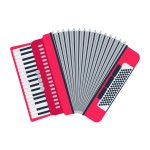Many great replies here, I just want to add a note about this question:
I'm reading between the lines a bit, but it sounds like there's another question here: "is a diatonic easier?"
A resounding no to that. I'd argue that diatonic instruments are more difficult. If you want a certain note, you not only have to know where it's located, but whether to push or pull the bellows. When you're playing a two or three-row diatonic, arranging or interpreting tunes has a puzzle-like quality - which is great fun, but not NOT easy. There are often multiple ways to play a single note on the right hand: one on the push, and one on the pull.. and those options dictate which chords you can produce with your left hand. And then, there are some notes that can only be played in one location/direction, so they sometimes render it impossible to play the bass/chord you want. So learning melodies often means learning the chords first, then applying the melody, remembering to change rows and directions where necessary, and learning to fake the passages where you can't quite match chord and note. Definitely not the easy path.
A 4- or 5-row chromatic button accordion also presents multiple options for each note. Many piano accordionists make the switch to these systems for the compactness and elegance of the layout. They make transposing tunes a breeze and they require much less hand gymnastics to leap between octaves. The layout is relational: a certain interval is the same reach from any given note. For example, two buttons in a row will always produce a minor third. The tradeoff for all this elegance, logic, and compactness is that the layout is more complex; it doesn't just run in order from low to high. It can be an intimidating beehive of notes when starting out.
With your musical tastes in mind, I think a piano accordion is really the easiest, not necessarily in the long run, but certainly for a beginner. It has a built-in diatonic scale (the white keys) and most teaching methods progress to other keys through the gradual addition of accidentals. The notes progress in order up the keyboard, and while the arrangement of accidentals is a little irregular, you can start to very quickly get a feel for the amount of space in an interval. This frees your mind up a bit to learn the other rudiments, like playing posture, left hand accompaniment, and bellows control. They're also easy to find on local listings. I started on these and moved to chromatics, then diatonics for certain genres. I have no regrets, except perhaps having spent a little longer on the piano accordion than was necessary. I still use the piano accordion for some things - each system has its strengths.
If you should become hooked on accordion playing, I think you may end up with more than one type of instrument. : )
I'm not sure if this touches on the reasoning behind ArtMustel's recommendation for the piano accordion. I absolutely agree with what they said, though. Keep an eye on local listings, try first, make sure it feels and sounds good, don't feel pressure to jump at the first one in your budget. And I'm relatively new here, but this seems like a great forum ask for feedback on specific instruments before making a purchase.

